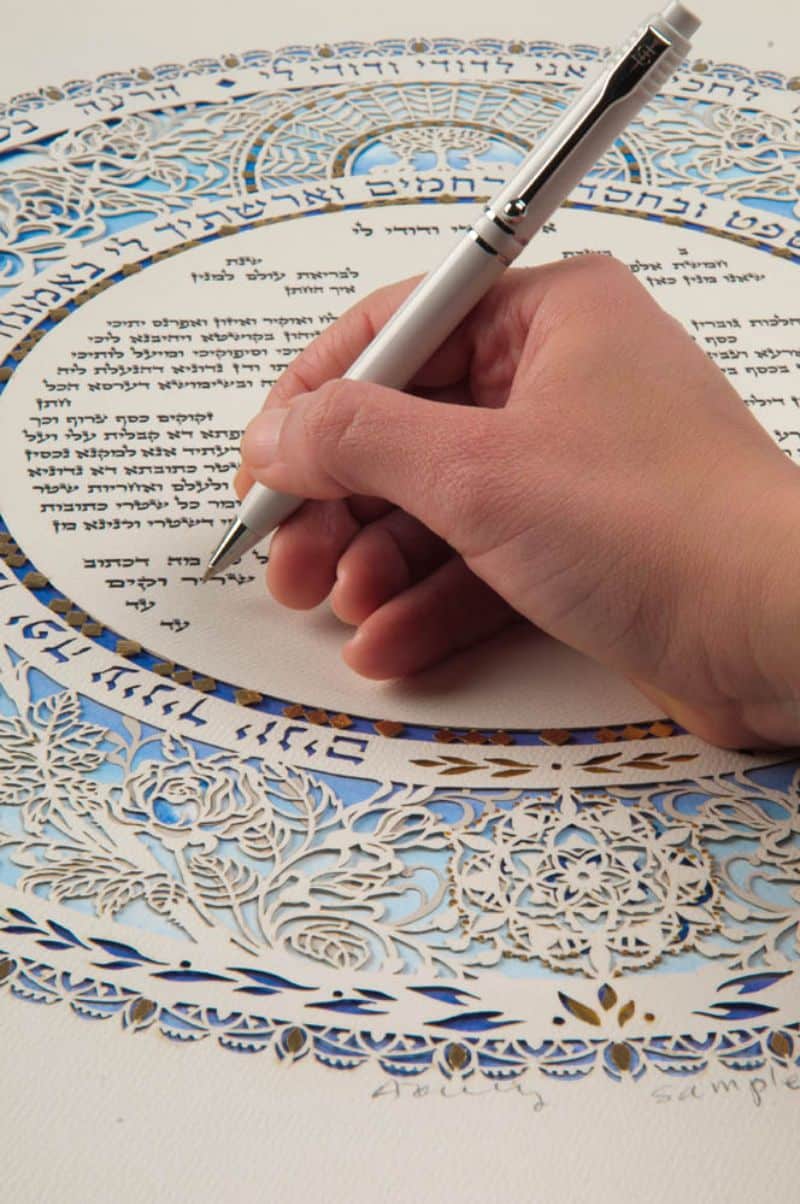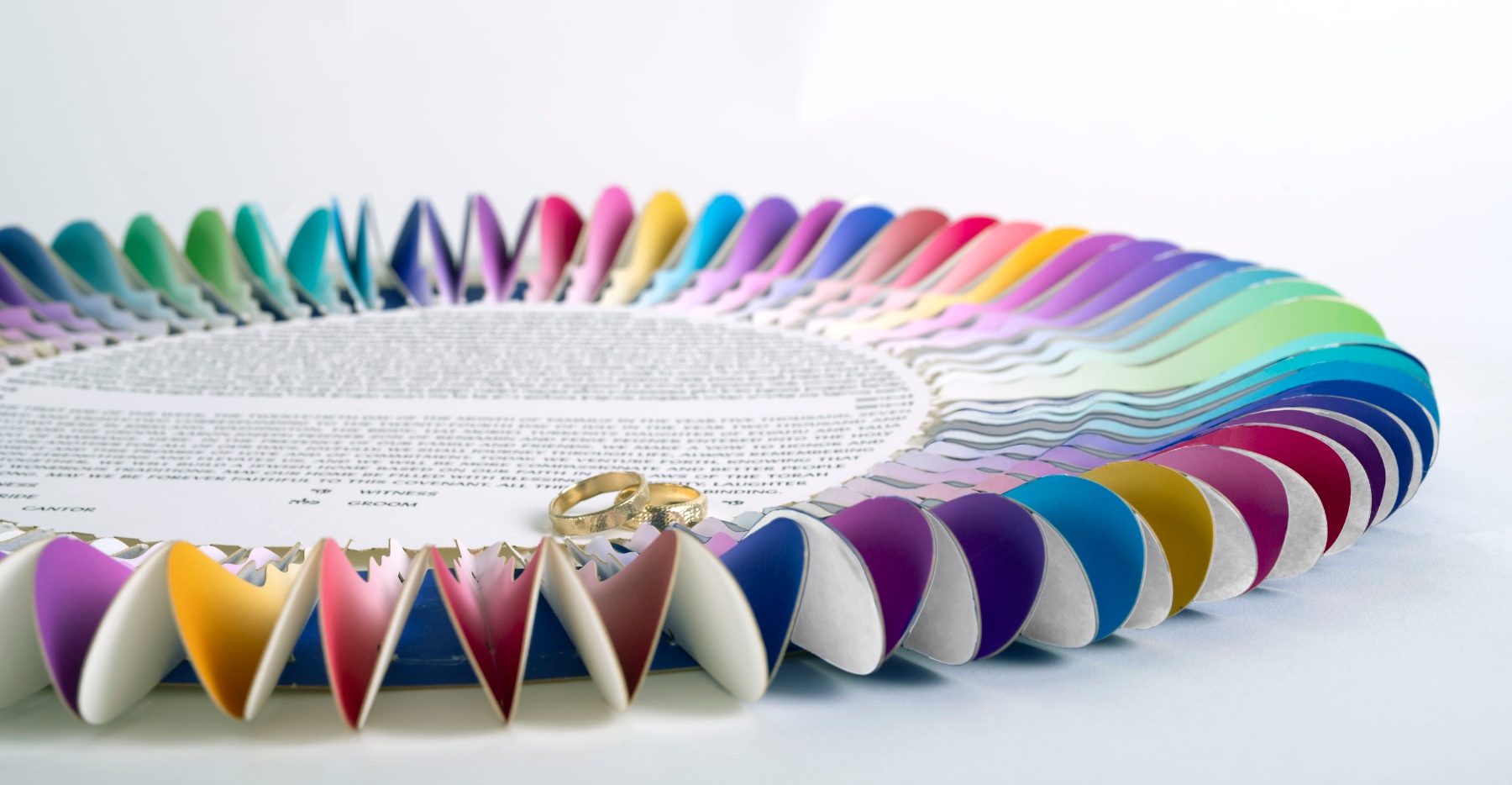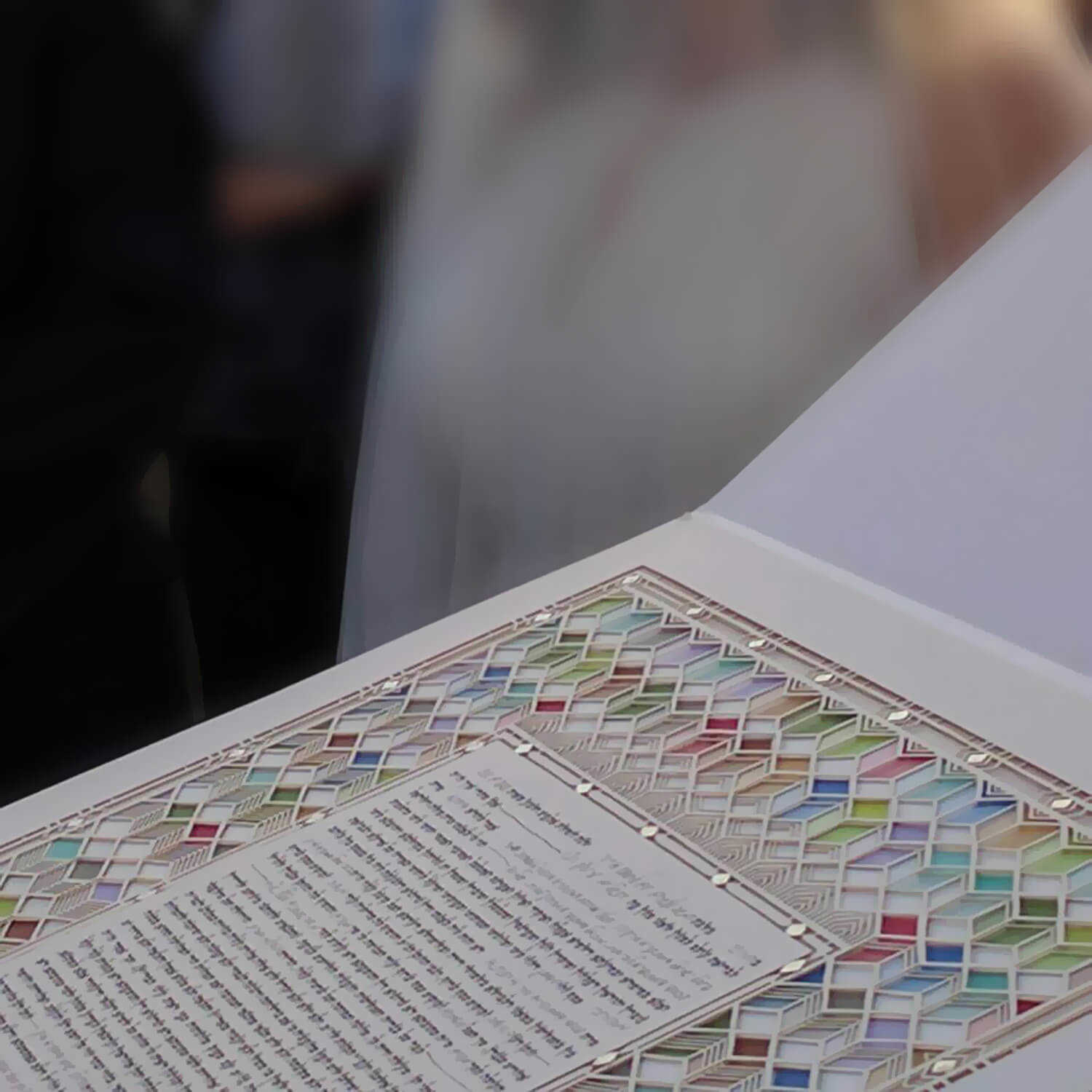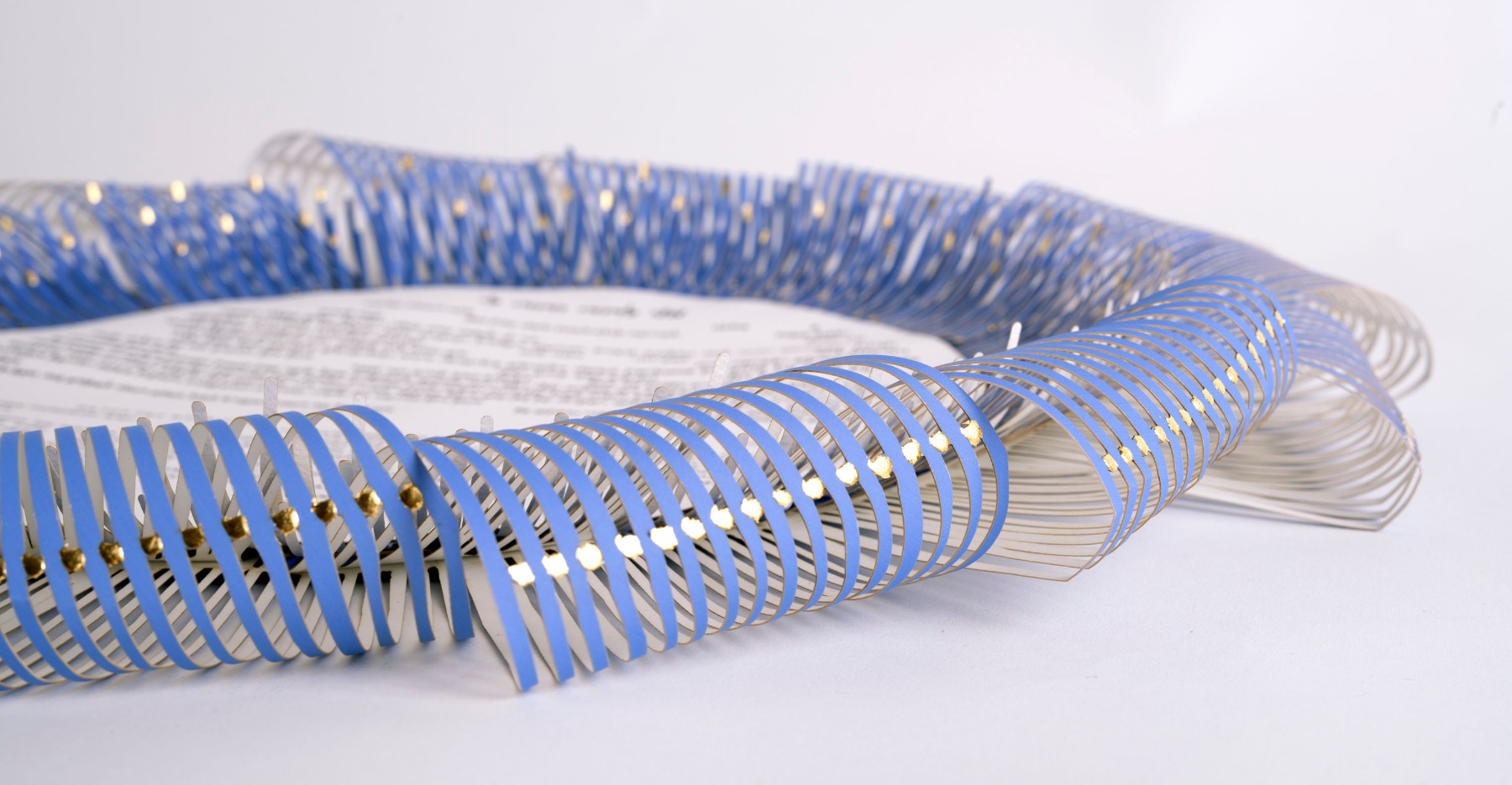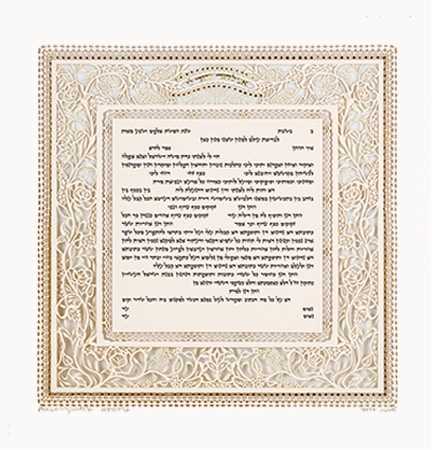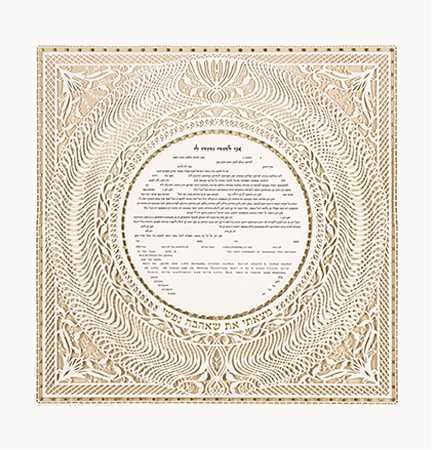KETUBAH DESIGN: AN OVERVIEW
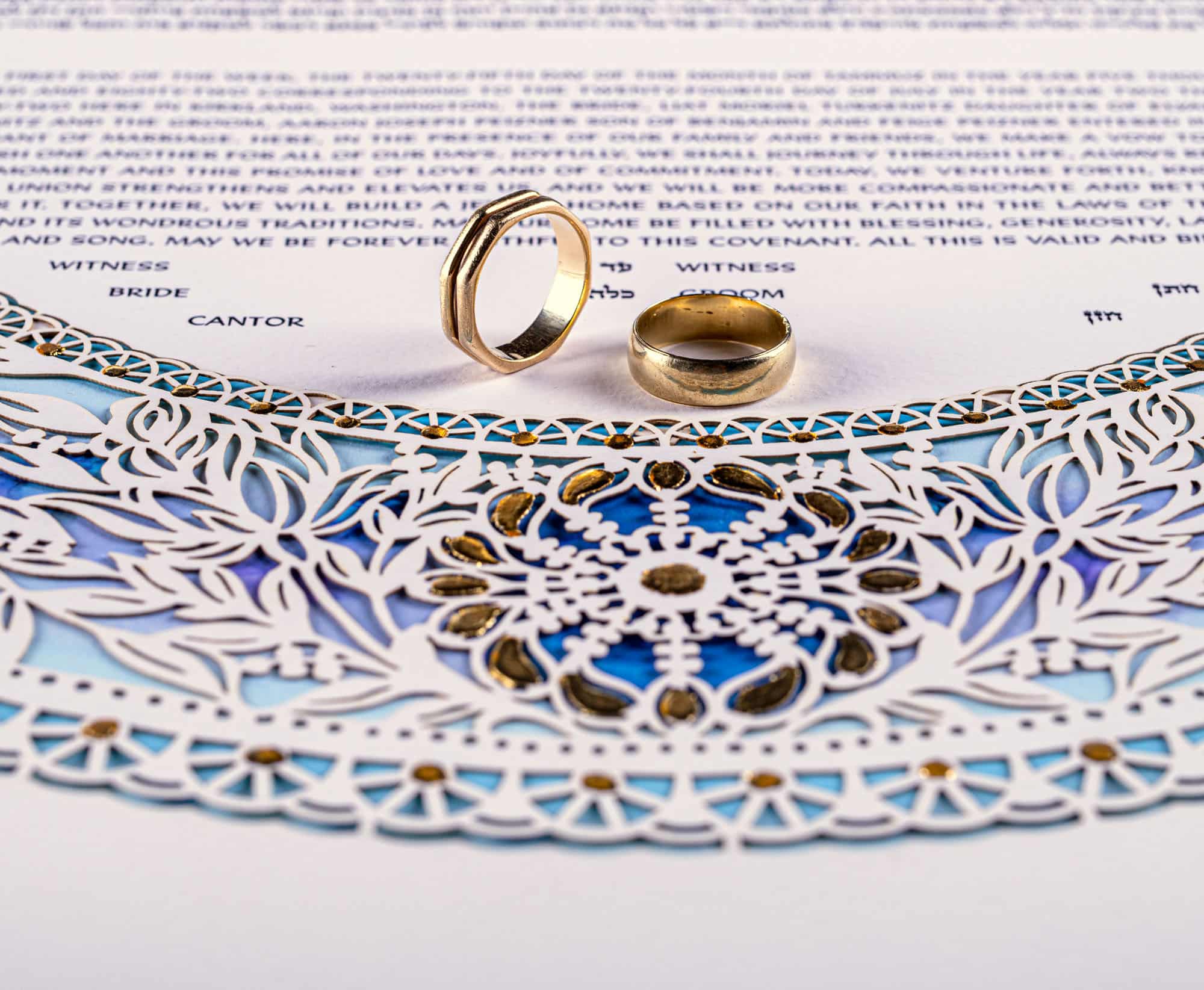
Judaism has historically inspired a wide array of Jewish religious art – whether it be handicrafts or fine art. From the remains of ancient synagogues such as Beit Alpha (in present day Israel) and Dura Europus (present-day Syria) to the two-dimensional artworks that have somehow been preserved and discovered; it is evident and persisted— and this being in spite of the prohibition of the creation of “graven images” cited in the second commandment.
You shall have no other gods beside Me. You shall not make for yourself a sculptured image, or any likeness of what is in the heavens above or on the earth below, or in the waters under the earth. Exodus: 20:4
Still, Jewish law dating from the Talmudic period, holds little restraints on creativity. Rather, it reinforced all artistic endeavors associated with the concept of hidur mitzvot: the enhancement of Jewish rituals with beauty. The Bible with its rich and detailed description of Bezalel, the artist/artisan and the construction of the First Temple and the Mishnah (Jewish Law) encourage the proliferation of art– be it the beautification of synagogues or the creation of ritual objects and manuscript illumination. Of course, the richness and prolificacy of ceremonial art grew entirely in accordance with the prevailing conditions of whatever economic and political constraints were placed on the Jewish people, who resided in diverse geographical locations on the Iberian Peninsula, in the Middle East and in Europe.
Two-Dimensional Jewish Religious Art & the Beautiful Ketubah
The tradition of two-dimensional Jewish art on parchment, leather, papyrus or paper (the law continued to forbid three-dimensional sculptures of humans and animals which had been so closely associated with idol worship in ancient times) including those of illuminated ketubahs can be traced, at least, to the Middle Ages. Although, the exact date when the ketubah became an integral part of the Jewish wedding ceremony cannot truly be pinpointed; its Rabbinic implementation goes back, at least, to the times of the Talmud (70 – 500 BCE) and some say unto Biblical times (an issue that still remains between Ashkenaz and Sephardic Jews). The language of the ketubah text, Aramaic was the legal language of Judaic law in these times, and would have been a language that was understood by the families of the bride and bridegroom. Since, the ketubah is a legal marriage contract, signed in the presence of two witnesses and not a holy scripture it was written in Aramaic and not Hebrew.
The adornment of ketubahs evolved in various Jewish communities but it is considered to have become “a thing” amongst the Spanish Jews. Later with the expulsion of the Jews of Spain in the late 15th century, they brought their artistic tradition of designed ketubahs with them to Italy (and beyond). The artistry and decorative details of beautiful ketubah design flourished in the milieu of Italy with its deep appreciation of art and aesthetics. The first known ketubah, displaying both sophistication and intricacy came out of Ancona, where the making of ketubah art became well established. In fact, the amount of money spent on the creation of more and more lavish ketubahs for one’s wedding day was finally capped by the rabbis who were in favor of modesty and temperance. Beautify, yes. Ostentatiousness, no.

The Ketubbot collection of the National Library of Israel, CC BY-SA 3.0 <https://creativecommons.org/licenses/by-sa/3.0>, via Wikimedia Commons
More than Just Jewish Religious Art
Though the ketubah’s text was pretty much the same in intention and close in wording from region to region, the art styles differed among the various Jewish communities. Jewish and non-Jewish artists were commissioned to do these beautiful pieces of art and utilized motifs and the artistic styles that were characteristic of their geographical location and that reflected the artistic traditions of their countries. These elements were combined and juxtaposed with the many Jewish motifs– which served as a visual shorthand for the newly wedded Jewish couple’s faith and values.
Consequently, the ketubah design that elevated the wedding contract to beautiful artwork, now years later, provides a window through which we can view the world in which these Jewish communities existed. In this way, the adorned ketubah is layered with meaning; a marriage contract, a stunning piece of art, a historical document of a wedding couple and a document that provides enormous opportunity to understand Jewish life through the eyes of an ethnographer.
Ketubah design from Muslim countries, mirror the religious and cultural norms of the area: the human form does not appear; rather, themes originated from the animal and plant worlds, geometric ornamentation and architectural features such as eastern-style pillars and pointy arches. Consider Italy, where historical ketubahs dating from the Renaissance are most often brightly colored and accented in gold leaf. They also included a wide margin surrounding the text in order to integrate Biblical scenes, as was the style format at the time. Interestingly, the Jewish communities of Eastern and Central Europe did not decorate their ketubahs. Rather, because it was simply a marriage contract for a Jewish couple and viewed as an ordinary legal document, they were carefully written but contained no Jewish religious art.

Ketubot Collection of the National Library of Israel, CC BY-SA 3.0 <https://creativecommons.org/licenses/by-sa/3.0>, via Wikimedia Commons
Ketubahs and the Modern World
Beginning with the period known as the Haskalah, or the Jewish Enlightenment, which took place in Germany in the late 18th century, Judaism underwent a vast transformation. Needless to say, this would begin to have a huge influence on Jewish art and ketubah art. Later with the rise of Liberal Judaism, would arise a questioning of the meaning of Jewish ceremonial rites and Jewish traditions; that which each individual searched for his/her own meaning in Jewish ritual. “What does this ritual mean to me?” Since then, this question has never stopped being asked.
And of course, it can be answered in an infinite number of ways.
So, it goes for ketubahs, as well. In the twentieth century, with the rise of feminism and egalitarianism between the sexes, the traditional ketubah text underwent changes (though not amongst the Orthodox communities) or was completely rejected. In a world where women were no longer necessarily financially dependent on their spouses, the Jewish marriage contract was seen as an anachronism at its best, and by its fiercest critics—as a document that was demeaning to women.
The changes that were made (and are still continuing to be made, e.g.-interfaith ketubahs and same sex ketubahs) in the modern ketubah were indicative of an evolving world and of the dynamic changes overtaking the Jewish world in particular and the world at large.
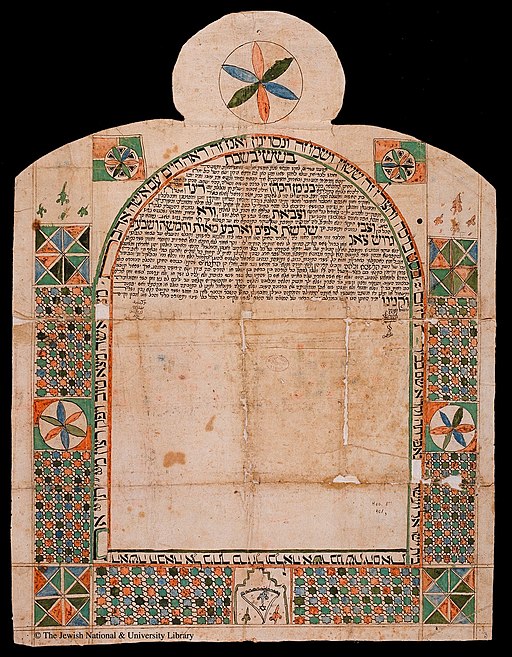
The Ketubbot collection of the National Library of Israel, CC BY-SA 3.0 <https://creativecommons.org/licenses/by-sa/3.0>, via Wikimedia Commons
The Ketubah Makes a Comeback
The poor misunderstood ketubah! Yes, it was accused of being a contract for buying a wife and of listing a woman’s duties to her husband, but this was never the case. At its very conception, it was the very thing– the legal document– that stood between a woman, facing financial destitution in the unfortunate case of widowhood, abandonment or an impulsive divorce and the ability for that woman to survive and establish herself once again in her environment. These were times that were very different from those that we now live in.
Once, the initial ketubah bashing had subsided, a new appreciation mounted for what the ketubah had been historically, and then, how it could be repurposed to suit the modern world.
Though, traditional Orthodox society still remains true to the traditional texts and their function as a legal Jewish wedding contract, the modern Jewish communities have, per say, rebirthed a modern ketubah. It has been transformed into a document, still celebrating the Jewish wedding day and marriage, but whose texts are much more an affirmation of the brides’ and grooms’ commitment to cherish one another and a written declaration of their joint commitment to their faith(s), values and aspirations. Much more in the style of wedding vows. It is a document that still is central to the Jewish marriage and very comfortably fits into a contemporary environment—one that embraces a pertinence and appropriateness to modern Judaism.

Ketubot Collection of the National Library of Israel, CC BY-SA 3.0 <https://creativecommons.org/licenses/by-sa/3.0>, via Wikimedia Commons
A Renaissance of Ketubah Design
Yes. What goes for the goose, goes for the gander. With the renewal and revival of the text, ketubah art began to revive and flourish once again—and today, it truly flourishes. Faithful to its history, ketubah art reflects who we are and how we live: what we believe in and in what our sense of beautiful is.
=How to describe modern ketubah design, today? It clearly mirrors the modern concept of the elevation of the individual and the incredible amount of personal choice that most of us have before us. Seascapes, landscapes, cityscapes…trees, bees, bears, skateboards… lilies, roses, robins, dinosaurs…abstracts, figurative, geometric, color washes. Paper cut ketubahs, watercolor ketubahs, wooden-inlaid ketubahs… You name it, it exists, or if not, at the very least, a custom ketubah can be made just for you. The selection is limitless: as limitless as our very own uniqueness. The color choices, too, are endless—monochromatic, bold primary colors, romantic pastels… Whatever you like. To paraphrase: A beautiful ketubah is in the eye of their beholder.
Of course, there are many Jewish couples who still prefer more traditional elements and more traditional designs– maybe with a bit of a modern twist: a lighter, brighter, whiter revamping of Jewish symbolic motifs, Jerusalem-scapes, menorahs, biblical themes: design which blends the contemporary with Judaism and Jewish heritage. These give a major nod to the endurance and continuity of the Jewish people. We have come from there and we are, at present, here. Now and through the generations, onwards. The ketubah, in itself– in its very essence– is the actual proof that this is true. True to the present with anawareness of its rich heritage.
With the steady increase of interfaith marriage and the rise in requests for interfaith ketubahs, in these last few decades, has come the necessity of expanding our design elements and motif alphabet; one that reflects those of the partners’ diverse faiths and cultural backgrounds. That, too, is manifest in contemporary ketubah art.
The art of the ketubah is the visual proof of who we once were– as Jewish individuals and as the Jewish people—and that, very evidently, continues to hold true for today.

